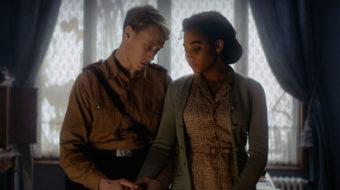Advertisement
Shot in glorious black and white, Cold War’s helmer Pawel Pawlikowski’s won the 2018 Cannes Film Festival’s Best Director award and the film was nominated for Cannes’ prestigious Palme d’Or. Cold War won six European Film Awards and as of this writing has won a total of 20 prizes and been nominated for another 32. In 2015 Pawlikowski’s Ida was nommed for a cinematography Oscar and earned the Best Foreign Language Academy Award (Ida was Golden Globe-nominated in the same category). Cold War is currently Poland’s official submission for the Best Foreign Language Oscar (although it was completely overlooked by the Golden Globes).
The premise of Pawlikowski’s Cold War is tried and true - but with a twist. In novels, operas, movies, etc., the City of Lights has long loomed as a beacon of artistic, personal and sexual freedom, beckoning creative talents to live and work in Paris. Some prominent examples include: Puccini’s 1895 archetypal opera La Boheme, which is set circa 1830 in the Latin Quarter, where Rodolfo and Marcello pursue poetry, painting, and but of course, Mimi. In Somerset Maugham’s The Moon and Sixpence the Englishman Charles Strickland moves from London to Paris because, as he explains: “I tell you I've got to paint. I can't help myself.” The 1919 novel was adapted for the screen in 1942, starring George Sanders. Paris’ spell was cast on a Yankee dauber in Vincente Minnelli’s 1951 Technicolor musical An American in Paris, starring Gene Kelly and Leslie Caron.
Writers, too, have been lured to Gay Paree. In the 1990 biopic Henry & June Fred Ward depicts novelist Henry Miller, who wrote erotic books such as The Tropic of Cancer in the French capital that would have been banned in Boston. Woody Allen won the Best Writing, Original Screenplay Oscar for his most successful movie, 2011’s Midnight in Paris, featuring Owen Wilson as Gil, who regains his literary inspiration when he goes back in time and meets celebrated artistes such as F. Scott Fitzgerald, Cole Porter, Josephine Baker, Gertrude Stein, Pablo Picasso, Ernest Hemingway, etc. in Parisian cafes. Hemingway summed this theme up in A Moveable Feast, which was Papa’s metaphor for Paris and the title of his 1964 memoir about Hem’s life as a struggling scribe in France during the 1920s.
So Pawlikowski’s Cold War is in a long line of works extolling the virtues of living, loving and creating in Paris. Since its characters are musicians, they are closer to Paul Newman and Sidney Poitier, who portrayed jazz musicians in Martin Ritt’s 1961 Paris Blues. But what makes Cold War stand out in this Parisian pack is its Polish pedigree. While members of the “Lost Generation” and so on came to Paris from the capitalist West, Cold War’s Wiktor (Tomasz Kot) and Zula (Joanna Kulig, who co-starred in Pawlikowski’s 2011 The Woman in the Fifth) emigrated from the Stalinist East. Therein lies the rub, comrades.
Cold War opens with a documentary style sequence (Warsaw-born Pawlikowski had a nonfiction filmmaking background and DP Lukasz Zal’s black and white cinematography enhances the documentary sensibility), as musicologists, including Wiktor, scour postwar Poland, recording native folk music like ethnomusicologist Alan Lomax did from 1937-1942. The action then shifts to Mazurek, a Ministry of Culture-funded folk music and dance collective headquartered at an estate in the countryside that, perhaps, was seized from large landowners and nationalized by the new socialistic government allied with the Soviet Union. (Mazurek is based on Mazowsze, an actual folk group established by the Polish state in 1948 to preserve regional traditions.)
There Wiktor, who is a gifted musician and instructor at this folk music institute, encounters the singer Zula, a beautiful blonde younger than him (the characters are inspired by co-writer Pawlikowski’s actual parents and share their names). A social climber on the make, there is a sexual frisson between the couple and they become lovers. Wiktor and Zula’s turbulent, tumultuous affair crosses boundaries, from Poland to East Berlin to Paris to Yugoslavia. What pushes Wiktor over the edge is when word comes down from on high that along with its traditional repertoire Mazurek is directed to include some Stalinist agitprop in its live performances. Kaczmarek (Borys Szyc) is an apparatchik and collaborator who spies on Mazurek and plays ball with the party hierarchy.
This leads to Wiktor’s defecting to West Berlin and then on to Paris, where he pursue his aspirations as a jazz musician - an art form looked down upon by the Stalinists. From 1949 to 1964 the lovers are repeatedly torn apart then reunited, their affair complicated by the vicissitudes of the actual Cold War between the socialistic camp in Eastern Europe and the capitalist countries of the West. But even when the temperamental partners are back together, Wiktor and the arriviste Zula inevitably clash - they are, so to speak, Poles apart. No détente or peaceful co-existence for them. The film’s title refers to Wiktor and Zula’s conflict-ridden romantic situation as much as it does to the East-West standoff.
Wiktor and Zula’s affair is a case study of “they can’t live together but can’t live without each other.” That whole “Oh Cathy!” “Oh Heathcliff!” syndrome that dates at least as far back as Emily Brontë’s 1847 Wuthering Heights. Like this whole emigrating to Paris for greater freedom theme, we’ve seen relationships like that of these tortured Polish lovers a million times before. But again, it is the film’s Eastern European milieu that distinguishes it from the many other servings of this timeworn dish.
Cold War offers a titillating look behind the so-called “Iron Curtain.” For Americans, the Warsaw Pact countries were as taboo to us as, say, rock and roll was to Eastern Europe. It’s interesting to see what state subsidization of the arts can accomplish. But like any patron of the art, from the Medicis to the Rockefellers, Communist Party largesse came with strings attached. The relatively privileged life of artists in the socialistic camp is interesting to observe, as is the devotion to preserving cultural heritage, even as the whole surveillance apparatus is reprehensible. I have always wanted to read a book or see a documentary without any ideological slant or propaganda about what life was really like under Eastern Europe’s approximation of socialism. The unvarnished positives and negatives. And I’ll tell you one thing: Poles, Bulgarians, Hungarians, Romanians, GDR Germans, etc., never dropped a single bomb on Vietnam and did nothing to support that war effort, which their governments strongly opposed - unlike many NATO members.
Cold War’s virtue is that, to some extent, it does allow Westerners to take an insider peep into the pluses and minuses of life under Stalinism. The Warsaw-born Pawlikowski’s own life has straddled the East and the West. Cold War’s look at Stalinist rule may also be a reference to anti-Western, authoritarian rule in a contemporary nationalistic Poland. The one hour, 28 minute red hot Cold War has English subtitles and opens Dec. 21.
L.A.-based reviewer/historian Ed Rampell is co-presenting a screening of Pasolini’s “The Gospel According to St. Matthew” 7:00 p.m., Dec. 27 at The L.A. Workers Center, 1251 S. St. Andrews Place, L.A., CA 90019. The third edition of “The Hawaii Movie and Television Book” co-authored by Rampell is now available at: https://mutualpublishing.com/product/the-hawaii-movie-and-television-book/ .



